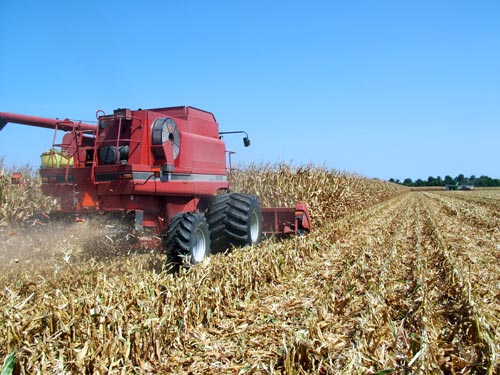
Mid-South corn yields all over the board as harvest starts
As of August 24, corn harvest was nearly 95 percent in Louisiana, but just getting started in north Mississippi and west Tennessee.Irrigation was one of the biggest expenses many Mid-South growers had this season, as hot, dry temperatures prevailed over much of the region.

Mid-South corn harvest is under way and early yields are indicating the importance of irrigation during dry years. Here’s more on the status of the crop, from Mid-South corn specialists.
Louisiana
According to John Kruse, Louisiana Extension corn specialist, corn harvest in the state is 90 percent to 95 percent complete. “The overall crop is going to be a little behind our statewide average from last year (140 bushels).”
Kruse said the drought that gripped much of Louisiana this season created a “huge division between irrigated and non-irrigated acres. The corn was much more affected than the cotton.”
Kruse said irrigated corn was consistently yielding 150 bushels to 225 bushels, with most falling between 175 bushels and 200 bushels. “Those are very respectable yields for Louisiana.”
Those good yields came at a price as many growers more than doubled their irrigation costs this season, Kruse said. “Diesel costs were up and the drought hit us hard.”
Dryland corn included some very disappointing yields as low as 30 bushels. “One grower told me when the yield is as low as the moisture, it’s time to quit. There were some other areas that captured the occasional rain shower that cut 110 bushels to 130 bushels dryland. Dryland yields were truly all over the map.”
Mississippi
Erick Larson, small grains specialist at Mississippi State University, said harvest was under way across much of the state (as of Aug. 24), “except for the north part of the state which is a good bit later.”
As in Louisiana, dryland and the irrigated crops are drastically different, noted Larson. “We had a tremendous amount of drought stress, and the dryland yields compared to previous dryland yields rate from poor to average. We’re not going to have a lot of above-average dryland yields.”
Larson said corn producers expended more money controlling weed issues in corn this season, including glyphosate-resistant pigweed and glyphosate-resistant Italian ryegrass. “Resistant ryegrass was much more substantial than it’s been in years past. To control it, growers are having to put out fall applications including a residual herbicide, followed by a second application in late January, followed by another cleanup burndown around planting time.”
Larson said a ryegrass infestation can result in as much as a 25 percent loss in yield potential with one ryegrass plant present in every 7 square feet.
Larson says aflatoxin issues “have not been abnormal relative to the amount of drought stress we’ve had.”
Arkansas
Jason Kelley, Extension wheat and feed grains specialist for the University of Arkansas, says corn producers are harvesting early-planted and dryland corn between rain showers. “About the time we get serious about harvest, we get all this high humidity or we catch some rains. Now we’re in a situation where it’s just not drying down at all. It’s been that way the last week and a half.”
Yields “are hit and miss,” Kelley said. “We have some pretty tough-looking dryland corn that’s just not going to make a lot. Once we get into the irrigated corn, we’re getting into all different yield levels. We have some good corn out there that was planted early and is yielding well. We have some planted early on different ground that suffered quite a bit from the heavy rain we had early. We’ve seen a lot of 175-bushel to 200-bushel corn, but I’m not hearing about yields of 250 bushels and above that we have some years.”
Late-planted and replanted corn in the state “looks good,” Kelley said, “but we haven’t really gotten into harvesting it. It’s taken a lot of heat, so we’ll have to wait and see. But from the road, it looks good.”
Kelley noted that this season “really demonstrates to producers what kind of watering capability they really have. Everything gets stretched, corn is very sensitive, especially right around silking. If water gets shorted a little bit, it shorts us on yield too.”
Kelley said producers on the west side of the state “have really been hurt. It’s tough when it’s 115 degrees in Fort Smith, and you still have corn that’s trying to fill. They’ve been exposed to some of that Texas and Oklahoma heat.”
Tennessee
West Tennessee combines were just getting started in corn in late August, according to Angela Thompson McClure, corn and soybean specialist for the University of Tennessee. “We haven’t harvested a lot yet. We’re probably about 5 percent complete.”
McClure said that corn harvested so far on hill ground, “that finished too early had low yields. Some of the better corn we’ve had was yielding in the upper 180-bushel range. But a lot has been in the 130- to 150-bushel range.”
USDA is projecting Tennessee yield of 136 bushels for this year, an improvement over last year’s 117-bushel average.
About the Author(s)
You May Also Like





